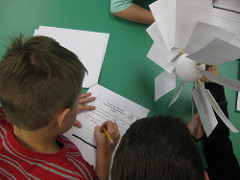Science education "trifecta"
By Mary Bigelow
Posted on 2017-02-12
 I’m looking for creative ways for students to share what they know, other than traditional written reports or essays. —K., Michigan
I’m looking for creative ways for students to share what they know, other than traditional written reports or essays. —K., Michigan
The creative process in science involves novel ways of thinking, problem solving, and communicating. When students are given the opportunity, encouragement, and support, their creativity can be astounding.
I found reworking information and/or experiences into another format can be an outlet for student design and creativity:
- An infographic on a science topic to display in the school or on a website
- A video or photo gallery documenting an activity
- A set of posters on a topic such as lab safety
- A “how-to” manual or video for an app or probe to be used as a tutorial for other students
- Vocabulary exercises that result in concept maps or illustrated word wall entries displayed in the classroom
- A video or presentation describing a concept to another audience
- Models or drawings
Designing and creating an informational product (such as a booklet, presentation, podcast, or video) for younger students on a science topic was a favorite of my high school students. An elementary teacher volunteered to review their work and discussed what was (or was not) appropriate for elementary students. The younger students also gave feedback and shared what they learned. My students demonstrated what they knew about the topic by explaining it to someone else. We had a trifecta: design process, useful product, and assessment.
The NSTA K-12 journals have many ideas for activities and projects, but projects shouldn’t be for teachers’ eyes only. When students display or share their work in the classroom, in another part of the school, with students in other grade levels, or with the community through a web page or live presentations, having an authentic audience adds another dimension.
Disclaimer: The views expressed in this blog post are those of the author(s) and do not necessarily reflect the official position of the National Science Teaching Association (NSTA).


